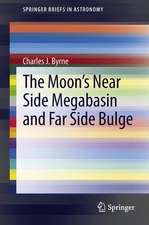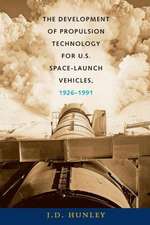Hyper-Velocity Impacts on Rubble Pile Asteroids: Springer Theses
Autor Jakob Delleren Limba Engleză Hardback – 16 dec 2016
The thesis presents a tool to create rubble pile asteroid simulants for use in numerical impact experiments, and provides evidence that the asteroid disruption threshold and the resultant fragment size distribution are sensitive to the distribution of internal voids. This thesis represents an important step towards a deeper understanding of fragmentation processes in the asteroid belt, and provides a tool to infer the interior structure of rubble pile asteroids.
Most small asteroids are 'rubble piles' – re-accumulated fragments of debris from earlier disruptive collisions. The study of fragmentation processes for rubble pile asteroids plays an essential part in understanding their collisional evolution. An important unanswered question is “what is the distribution of void space inside rubble pile asteroids?” As a result from this thesis, numerical impact experiments can now be used to link surface features to the internal structure and therefore help toanswer this question.
Applying this model to asteroid Šteins, which was imaged from close range by the Rosetta spacecraft, a large hill-like structure is shown to be most likely primordial, while a catena of pits can be interpreted as evidence for the existence of fracturing of pre-existing internal voids.
| Toate formatele și edițiile | Preț | Express |
|---|---|---|
| Paperback (1) | 635.47 lei 6-8 săpt. | |
| Springer International Publishing – 29 apr 2018 | 635.47 lei 6-8 săpt. | |
| Hardback (1) | 641.71 lei 6-8 săpt. | |
| Springer International Publishing – 16 dec 2016 | 641.71 lei 6-8 săpt. |
Din seria Springer Theses
- 18%
 Preț: 997.88 lei
Preț: 997.88 lei -
 Preț: 389.88 lei
Preț: 389.88 lei - 15%
 Preț: 646.94 lei
Preț: 646.94 lei - 18%
 Preț: 943.43 lei
Preț: 943.43 lei -
 Preț: 399.29 lei
Preț: 399.29 lei - 18%
 Preț: 944.99 lei
Preț: 944.99 lei - 15%
 Preț: 636.80 lei
Preț: 636.80 lei - 18%
 Preț: 941.05 lei
Preț: 941.05 lei - 15%
 Preț: 643.16 lei
Preț: 643.16 lei - 15%
 Preț: 642.68 lei
Preț: 642.68 lei - 18%
 Preț: 1103.62 lei
Preț: 1103.62 lei - 20%
 Preț: 558.83 lei
Preț: 558.83 lei - 18%
 Preț: 1112.30 lei
Preț: 1112.30 lei - 18%
 Preț: 944.19 lei
Preț: 944.19 lei - 18%
 Preț: 1109.92 lei
Preț: 1109.92 lei - 18%
 Preț: 1217.27 lei
Preț: 1217.27 lei - 15%
 Preț: 640.06 lei
Preț: 640.06 lei - 15%
 Preț: 636.45 lei
Preț: 636.45 lei - 15%
 Preț: 640.06 lei
Preț: 640.06 lei - 15%
 Preț: 640.88 lei
Preț: 640.88 lei -
 Preț: 389.70 lei
Preț: 389.70 lei - 20%
 Preț: 563.91 lei
Preț: 563.91 lei -
 Preț: 393.35 lei
Preț: 393.35 lei - 15%
 Preț: 637.93 lei
Preț: 637.93 lei - 15%
 Preț: 641.85 lei
Preț: 641.85 lei - 18%
 Preț: 1225.94 lei
Preț: 1225.94 lei - 20%
 Preț: 551.36 lei
Preț: 551.36 lei - 18%
 Preț: 1229.10 lei
Preț: 1229.10 lei - 15%
 Preț: 639.25 lei
Preț: 639.25 lei - 18%
 Preț: 999.45 lei
Preț: 999.45 lei - 15%
 Preț: 640.06 lei
Preț: 640.06 lei - 18%
 Preț: 1220.45 lei
Preț: 1220.45 lei - 18%
 Preț: 1116.26 lei
Preț: 1116.26 lei - 18%
 Preț: 1110.72 lei
Preț: 1110.72 lei - 18%
 Preț: 1000.87 lei
Preț: 1000.87 lei - 18%
 Preț: 891.17 lei
Preț: 891.17 lei - 15%
 Preț: 640.06 lei
Preț: 640.06 lei - 5%
 Preț: 1154.07 lei
Preț: 1154.07 lei - 15%
 Preț: 635.96 lei
Preț: 635.96 lei - 15%
 Preț: 640.88 lei
Preț: 640.88 lei -
 Preț: 387.20 lei
Preț: 387.20 lei - 18%
 Preț: 1109.92 lei
Preț: 1109.92 lei -
 Preț: 385.25 lei
Preț: 385.25 lei -
 Preț: 385.25 lei
Preț: 385.25 lei - 18%
 Preț: 1112.30 lei
Preț: 1112.30 lei - 18%
 Preț: 999.45 lei
Preț: 999.45 lei -
 Preț: 386.99 lei
Preț: 386.99 lei - 15%
 Preț: 637.13 lei
Preț: 637.13 lei - 20%
 Preț: 554.21 lei
Preț: 554.21 lei - 20%
 Preț: 555.59 lei
Preț: 555.59 lei
Preț: 641.71 lei
Preț vechi: 754.95 lei
-15% Nou
Puncte Express: 963
Preț estimativ în valută:
122.83€ • 133.47$ • 103.24£
122.83€ • 133.47$ • 103.24£
Carte tipărită la comandă
Livrare economică 21 aprilie-05 mai
Preluare comenzi: 021 569.72.76
Specificații
ISBN-13: 9783319479842
ISBN-10: 3319479849
Pagini: 822
Ilustrații: XXIX, 164 p. 69 illus., 55 illus. in color.
Dimensiuni: 155 x 235 x 13 mm
Greutate: 0.45 kg
Ediția:1st ed. 2017
Editura: Springer International Publishing
Colecția Springer
Seria Springer Theses
Locul publicării:Cham, Switzerland
ISBN-10: 3319479849
Pagini: 822
Ilustrații: XXIX, 164 p. 69 illus., 55 illus. in color.
Dimensiuni: 155 x 235 x 13 mm
Greutate: 0.45 kg
Ediția:1st ed. 2017
Editura: Springer International Publishing
Colecția Springer
Seria Springer Theses
Locul publicării:Cham, Switzerland
Cuprins
Introduction.- Methods.- A New Approach to Modelling Impacts on Rubble Pile Asteroid Simulants.- Impacts on Rubble Pile Asteroid Šteins.- Discussion.
Notă biografică
Jakob Deller has defended his PhD thesis in September 2015. His PhD project was jointly accompanied and funded by the University of Kent and the Max Planck Institute for Solar System Research, Göttingen. He was awarded the Pierazzo International Student Travel Award by the Planetary Science Institute, Tucson, Arizona, and presented his work in multiple international conferences. He gained observing experience at the NTT at La Silla Observatory, Chile.
He was awarded his M. Sc. in November 2011 with a thesis on the ‘Stability of some recently found circumbinary systems’ supervised by Prof. Dr. S. Dreizler at the Institute for Astrophysics Göttingen, Germany.
Textul de pe ultima copertă
The thesis presents a tool to create rubble pile asteroid simulants for use in numerical impact experiments, and provides evidence that the asteroid disruption threshold and the resultant fragment size distribution are sensitive to the distribution of internal voids. This thesis represents an important step towards a deeper understanding of fragmentation processes in the asteroid belt, and provides a tool to infer the interior structure of rubble pile asteroids.
Most small asteroids are 'rubble piles' – re-accumulated fragments of debris from earlier disruptive collisions. The study of fragmentation processes for rubble pile asteroids plays an essential part in understanding their collisional evolution. An important unanswered question is “what is the distribution of void space inside rubble pile asteroids?” As a result from this thesis, numerical impact experiments can now be used to link surface features to the internal structure and therefore help toanswer this question.
Applying this model to asteroid Šteins, which was imaged from close range by the Rosetta spacecraft, a large hill-like structure is shown to be most likely primordial, while a catena of pits can be interpreted as evidence for the existence of fracturing of pre-existing internal voids.
Caracteristici
Nominated as an outstanding PhD thesis by the University of Kent, UK Provides a tool to link surface features to the internal structure of asteroids Applies the tool to asteroid (2867) Šteins, which constrains the configuration of voids inside this asteroid

















